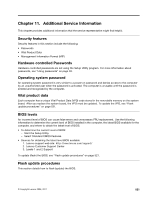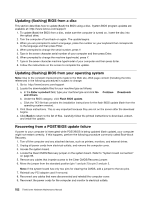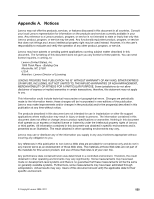Lenovo ThinkCentre M58e Hardware Maintenance Manual - Page 529
Power management, Automatic configuration and power interface (ACPI) BIOS, Automatic Power-On features - power consumption
 |
View all Lenovo ThinkCentre M58e manuals
Add to My Manuals
Save this manual to your list of manuals |
Page 529 highlights
10. Turn on the computer and the monitor. Insert the POST/BIOS update (flash) disc into the optical drive. 11. Turn the computer off and back on again. 12. The recovery session will take two to three minutes. During this time you will hear a series of beeps. After the update session is completed, there will be no video, the series of beeps will end, and the system will automatically turn off. Remove the disc from the optical drive before the system completely turns off. 13. Repeat steps 2 through 5. 14. Replace the Clear CMOS/Recovery jumper to its original position (pin 1 and pin 2). Note: If the system board has only two pins for clearing the CMOS, remove the jumper from the two pins. 15. Reinstall the PCI adapter card if removed. 16. Reconnect any cables that were disconnected and reinstall the computer cover. 17. Turn on the computer to restart the operating system. Power management Power management reduces the power consumption of certain components of the computer such as the system power supply, processor, hard disk drives, and some monitors. Automatic configuration and power interface (ACPI) BIOS Being an ACPI BIOS system, the operating system is allowed to control the power management features of the computer and the setting for Advanced Power Management (APM) BIOS mode is ignored. Not all operating systems support ACPI BIOS mode. Automatic Power-On features The Automatic Power-On features within the Power Management menu allow you to enable and disable features that turn on the computer automatically. • Serial Port A Ring Detect: With this feature set to Enabled and an external modem connected to serial port (COM1), the computer will turn on automatically when a ring is detected on the modem. • PCI Modem Ring Detect: With this feature set to Enabled, the computer will turn on automatically when a ring is detected on the internal modem. • PCI Wake Up: This feature allows PCI cards that support this capability to wake the system. • Wake Up on Alarm: You can specify a date and time at which the computer will be turned on automatically. This can be either a single event or a daily event. • Wake on LAN: If the computer has a properly configured token-ring or Ethernet LAN adapter card that is Wake on LAN-enabled and there is remote network management software, you can use the Wake on LAN feature. When you set Wake on LAN to Enabled, the computer will turn on when it receives a specific signal from another computer on the local area network (LAN). Chapter 11. Additional Service Information 523















